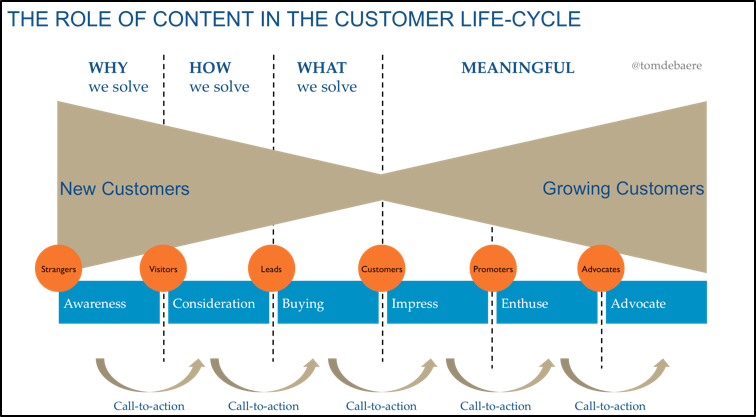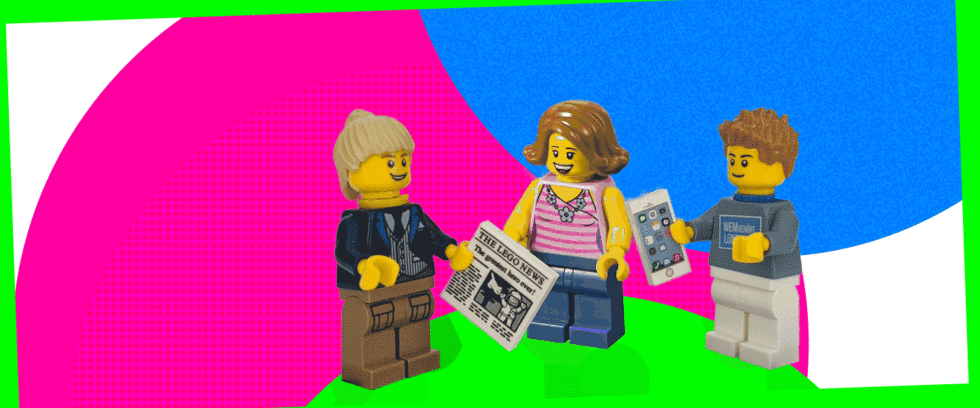By Kevin J. Davis and Mark Lee Hunter
Travelling with your Customer
A customer journey map allows the organization to understand and explore all the possible channels and pathways that your potential customer follows to engage with your products and services. Such a map illustrates every potential touchpoint, and also reveals the customer’s feelings along the journey. Defining the emotional state of a target member helps us understand how to effectively inform, communicate with and market to potential customers, depending on where they are in the journey.
The following graphic contains a detailed hypothetical example of how a customer journey might look for users who move from anonymity to a membership decision based on their interaction with particular content (we use the example of a local story). In fact, customer journey map styles are as varied as the types of businesses and industries that regularly utilize them:

The goal is to create a continuous path for your customer.
As Blake Pappas writes in Vertical Measures: “Your business cannot afford to have content gaps in the customer journey. Otherwise, potential customers will have no choice but to leave your company behind and find solutions to their challenges elsewhere.” In other words, once they’re interested, you must keep them interested.
Two points are key here, because they define a powerful feedback loop: (1) The customer journey informs every touchpoint with the target individual, meaning that we position those touchpoints along the journey. (2) In parallel, every interaction between the individual and our organization informs our understanding of the customer journey.
Content drives the customer life cycle
The first content producers who effectively drove people through their funnels were the marketers who created “native advertising” (formerly known as “advertorial”). We have much to learn from the people who made it work. Marketer Tom De Baere provides this insightful graphic about the way customers interact with native advertising:

http://www.b2bmarketingexperiences.com/2013/05/killer-content-along-the-buyers-journey-a-practical-guide-to-monetize-your-content/
Note several features of De Baere’s concept:
(1) Content is characterized by its relation to the customers’ problems – the pain points we are trying to heal.
(2) Every step in fixing the pain is accompanied by a call to action. The actions move from investing attention, judging the content, purchasing something, appreciating it, and getting excited about it, to promoting it to others. In the process, the customer changes from a stranger into an advocate.
“Each time you have an idea for content, you can test it against this model. Specifically, by watching the customer’s actions, you can observe the efficacy of specific content and particular calls to action at every stage in the journey.“
Tom De Baere
Organizations that take the time to map the customer journey experience gain insight into what type of content drives which types of interactions with specific people. They also learn to maximize the desired impact of their content on the target audience. When done right, this is an iterative, ethical process that gets refined over time. “Customer journey maps should be adjusted on an ongoing basis to answer the question, ‘How can we add more value to our visitors at each step of this journey?’” observes leading eCommerce services provider Shopify. (Shopify also provides a very handy customer persona and Journey Mapping template, available for free download.)
Once again, commitment to doing this right means paying constant attention to key data points as you accompany your target individuals from one end of the journey to the other. The initial investment is imagination, followed by setting up systems that enable tracking customer responses to content and their subsequent actions. We discuss currently available systems in the Appendix.
Journalists as marketers
Most of the thousands of independent journalists and publishers whom we’ve met in different contexts think of marketing and advertising as synonymous. They are not. Advertising is only one highly visible form of marketing. This confusion carries a high cost: Talented journalists fail to understand how marketing can help them achieve their desired impact.
Journalists frequently think of marketing as telling lies to obscure more or less fraudulent practices, a way of selling excrement as ice cream. That’s what happens when you hear seemingly respectable people, like public figures, lie shamelessly day in and out. But there’s another way to look at marketing, well expressed by Seth Godin: “Marketing is the generous act of helping someone solve a problem – their problem.” He adds: “Marketing involves very little in the way of shouting, hustling or coercion. It’s a chance to serve, instead.” Or as our colleague Markus Christen said when he taught the subject at INSEAD, “Marketing is making the truth attractive.”
To us, that sounds a lot like what we are trying to do with our stories – give people who need to know the truth an exciting and enriching way to learn it. In fact, when we compare quality journalism to ethical marketing, we see a number of common practices, which we summarize in the chart below:
| Journalists | Marketers | |
| Produce, distribute, promote and sell a product or service | ✅ | ✅ |
| Leverage innovation and creativity to reach and communicate brand + values | ✅ | ✅ |
| Leverage stories and storytelling to inform and engage | ✅ | ✅ |
| Desire to create impact and change | ✅ | ✅ |
| Ability to communicate and measure impact | ✅ | ✅ |
All of your interventions during a customer journey, including the journalism you commit, count as marketing. The issue isn’t whether you do it – like it or not, you’re already doing it – but how.
How, then, can resource-starved news organizations get started and build on their first learnings, whether or not they can afford a full-time marketing director? Part of the answer is that everyone on the team must understand and accept that he or she is responsible for reaching the people who need us. Journalists can bring particular skills to this work: Finding those people (whether they are the expats who support an exile media, or the leading members of a shared identity community), and telling stories, including our own stories.
Godin has conceptualized this kind of marketing, which we have taken the liberty to modify for community-centric journalists:
- Invent something necessary. Your mission statement describes it; if it doesn’t, start over. You can start with something that’s necessary to you. But you can’t stop there.
- Design and build it so that your smallest viable market, otherwise known as the community you wish to super-serve, will particularly benefit from it and care about it. From now on, their needs come first.
- Go inside that community and stay. Never flinch from serving your community’s needs, courageously and generously. Show them who you are, and what you’re there to do.
- Spread the word about what you’re doing, and help the community spread it for and with you.
News organizations that share the marketing function across teams, which is what we are proposing, have to decide who, specifically, they wish to impact – or in other words, to whom they are especially necessary. (The answer is never “everyone”. If you are the alternative to the local oligarch’s captive media, he and his supporters need you like the flu.)
Project leaders must ask: What is this for? What does it do for our target community? Is this something that they already know they need? If not, how will they discover that they need it? The answers can be hypothetical, but they must be defined well enough to determine which interventions to undertake, what they are intended to accomplish, and how their efficacy will be measured.
Now over to you:
Ultimately, we want to convert potential members and subscribers at the end of the customer journey, and keep them with us. Have you tried tracking customer journeys and what did you take away from it?
If you want to talk about your experience, let us know. We’re always looking for cases to study and write about: dialogger@tactile.news
Excerpted from Community-Powered Journalism: A Manual for sustainability and growth in independent news (publication pending; copyright 2018-2020 Davis and Hunter, all rights reserved).


Neueste Kommentare